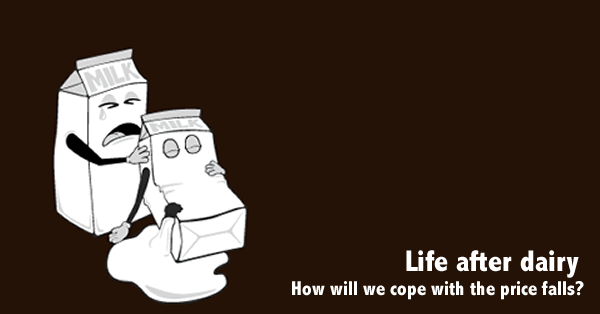Dairy prices continued their tumble last week, crushing anyone who had remained optimistic about the short-term prospects for the industry. But what about the long-term prospects, and what does the price drop mean for our fresh water quality?
Prospects
I’m writing this in Canterbury, which has been the heart of the recent dairy boom. To be honest I expected to see a bit more doom and gloom than I have encountered here. The dairy price collapse means that many in this region didn’t make a profit this year, and won’t the next either.
But most dairy farmers have seen years like this before and knew this was coming. In fact this is true for all types of farmers. The sort of doom and gloom that we hear through the media simply doesn’t really bear out in reality. The fact is that the majority of farmers have plenty of equity in their farms, and can weather a few bad years. There are certainly some heavily indebted farmers – the Reserve Bank tells us that half the dairy debt is held by 10% of farmers. So we will certainly hear some yelps of pain from this indebted tail of farmers if prices stay low for long enough. But it won’t be the end of the industry in Aotearoa New Zealand.
Changing how we farm
The more likely legacy of this price fall is a change in how we farm. The boom time saw farmers throw more palm kernel, supplements, fertilizer and water onto the land in order to maximise production. The easiest way to see this trend is by tracking our imports of palm kernel expeller (PKE), which peaked at a whopping 2.2 million tonnes in 2014.
But these supplements all cost money (even the relatively cheap PKE), and now that extra production doesn’t justify spending that money. So we will see farmers paring back, cutting stock numbers, farming fewer cows and making less milk. That means less income, but it also means far lower costs. As our farmers like to say – you don’t have to pay for the rain and sun – and we are blessed with both those in this land.
Luckily this is not only a more financially sustainable way to farm, it is better for the environment too. Fewer cows on the land means less nutrients end up in our waterways, which means our rivers, lakes and aquifers will be better off.
A lower milk price will also see fewer farmers converting their land to dairy. This is also good news for our fresh water – in fact arguably the lower milk price will do more for our environment than our Government’s fresh water policy. Hopefully this lower price will buy our fresh water precious time for the Regional Councils to act, and so we won’t see the same burst of conversions when the milk prices rise again.
However, the old adage that you can’t be green if you are in the red still holds. We want a profitable primary industry so that they can afford to look after the environment. We won’t see many farmers making large investments to improve their environmental footprint at the current milk price. Thankfully, most dairy farmers have already made these investments – the most likely environmental improvement to get delayed nowadays is the planting of riverbanks.
Will prices rise again?
This, for Aotearoa New Zealand, is the billion dollar question. Lower milk prices are hurting here, but you can bet that in the long term they will be hurting more in the US and Europe where the costs farming are higher because feed has to be grown, harvested and brought to the cattle in their sheds. This is the advantage we have always had in New Zealand, which is why we will probably revert to our old ways of farming.
So will prices rise again? We can never know for sure – the world dairy market is a volatile thing and much depends on demand in Asia and how much other countries produce. For example, the recent burst of production in America has come because their corn is currently so cheap.
The rest of the economy
Meanwhile, the rest of our export economy will be smiling as our dollar heads south – the lower the payout goes, the better our export prospects become. And this is the double-edged sword of being a ‘supply economy’ – relying heavily on primary produce. The high dollar that results when our terms of trade (the prices we get from the world for the stuff we make) are good kills off any other potential exporting businesses. Make no mistake we want our dollar to be as high as possible, that maximises our spending power. But of course it has to be sustainable, we have to be able to profitably export at the exchange rate.
So bad times for dairy mean good times for other exporters – such as tourism, forestry and software. Hopefully with this price drop they can have long enough in the sun to establish a permanently stronger position on the world stage.


